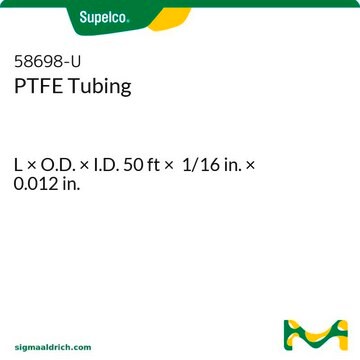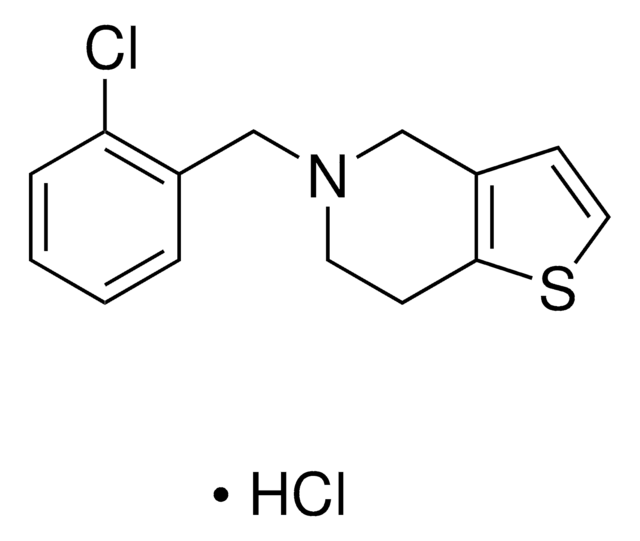71376
Cloruro de sodio
BioUltra, for molecular biology, ≥99.5% (AT)
Sinónimos:
Halita, sal de roca, NaCl
About This Item
Productos recomendados
grade
for molecular biology
Quality Level
vapor pressure
1.33 (1.00 mmHg) at 865 °C hPa
product line
BioUltra
assay
≥99.5% (AT)
form
solid
availability
not available in (Sales restrictions may apply)
technique(s)
mass spectrometry (MS): suitable
western blot: suitable
impurities
DNases, none detected
RNases, none detected
insoluble matter, passes filter test
phosphatases, none detected
proteases, none detected
≤0.001% total nitrogen (N)
pH
5.0-8.0 (25 °C, 1 M in H2O)
mp
801 °C (lit.)
solubility
H2O: 1 M at 20 °C, clear, colorless
density
2.16 g/cm3 at 25 °C (77 °F)
anion traces
bromide (Br-): ≤50 mg/kg
hexacyanoferrate(II) ([Fe(CN)6]4-): ≤1 mg/kg
iodide (I-): ≤10 mg/kg
phosphate (PO43-): ≤5 mg/kg
sulfate (SO42-): ≤200 mg/kg
cation traces
Al: ≤5 mg/kg
As: ≤0.1 mg/kg
Ba: ≤5 mg/kg
Bi: ≤5 mg/kg
Ca: ≤10 mg/kg
Cd: ≤5 mg/kg
Co: ≤5 mg/kg
Cr: ≤5 mg/kg
Cu: ≤5 mg/kg
Fe: ≤1 mg/kg
K: ≤50 mg/kg
Li: ≤5 mg/kg
Mg: ≤5 mg/kg
Mn: ≤5 mg/kg
Mo: ≤5 mg/kg
Ni: ≤5 mg/kg
Pb: ≤5 mg/kg
Sr: ≤5 mg/kg
Zn: ≤5 mg/kg
SMILES string
[Na+].[Cl-]
λ
1 M in H2O
UV absorption
λ: 260 nm Amax: ≤0.01
λ: 280 nm Amax: ≤0.01
suitability
suitable for component for culture media
suitable for molecular biology
application(s)
genomic analysis
InChI
1S/ClH.Na/h1H;/q;+1/p-1
InChI key
FAPWRFPIFSIZLT-UHFFFAOYSA-M
¿Está buscando productos similares? Visita Guía de comparación de productos
General description
Application
- as a component of buffer solution to prepare the pH solutions for open-circuit potential and cyclic voltammetry
- in the preparation of Bold’s basal medium (BBM)
- as a component of transcription and annealing buffer
- to maintain osmotic balance and ensure the purity and stability of the isolated extracellular vesicles (EVs)
- as a buffer for the lamination of lateral flow strips in the fabrication of lateral flow devices
Biochem/physiol Actions
Features and Benefits
- Suitable for molecular biology and biochecmial research
- Free from DNase, RNase, NICKase and protease
- Tested to confirm low levels of heavy metal contamination, ensuring suitability for various applications.
- Tested for the presence of Anionic and Cationic traces
Other Notes
Comparable product
Storage Class
13 - Non Combustible Solids
wgk_germany
WGK 1
flash_point_f
Not applicable
flash_point_c
Not applicable
ppe
Eyeshields, Gloves, type N95 (US)
Elija entre una de las versiones más recientes:
¿Ya tiene este producto?
Encuentre la documentación para los productos que ha comprado recientemente en la Biblioteca de documentos.
Los clientes también vieron
Nuestro equipo de científicos tiene experiencia en todas las áreas de investigación: Ciencias de la vida, Ciencia de los materiales, Síntesis química, Cromatografía, Analítica y muchas otras.
Póngase en contacto con el Servicio técnico



